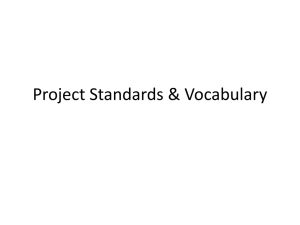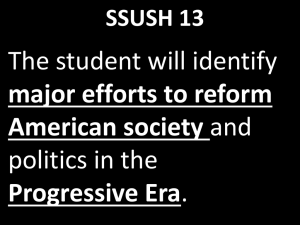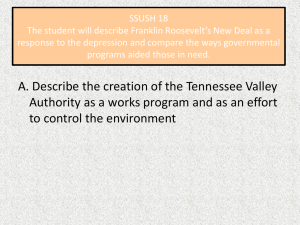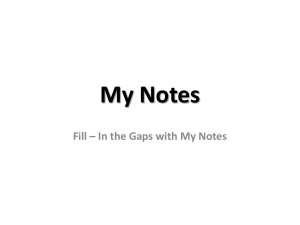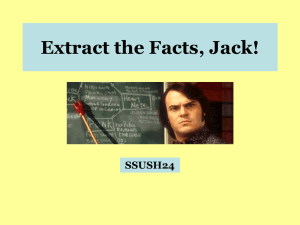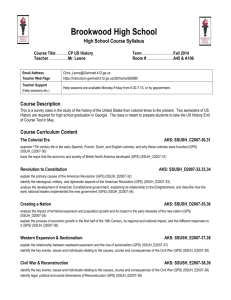Decades Between War
advertisement
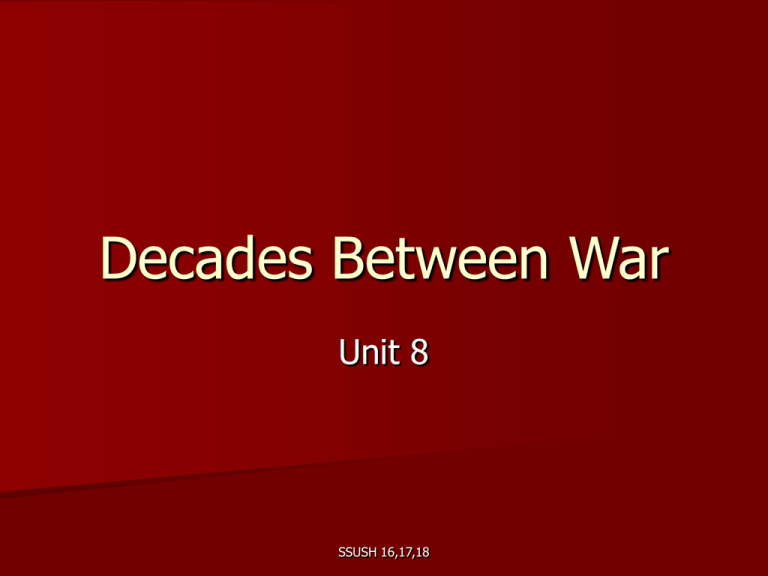
Decades Between War Unit 8 SSUSH 16,17,18 The Roaring Twenties After WWI, people in the United States wanted a return to the security from before the war. 1920, they elected Warren G Harding president of the United States. He wanted a “return to normalcy” The 1920s ended up being a decade of great change and innovation SSUSH 16,17,18 Warren G. Harding 1865-1923 29th President; 1920-1923 Died from a heart attack while in office quoted as saying "I am not fit for this office and never should have been here.“ Succeeded by Calvin Coolidge Republican SSUSH 16,17,18 Calvin Coolidge 1872-1933 30th President of US; 1923-1928 Republican SSUSH 16,17,18 “Red Scare” and Immigration 1917 – Bolshevik revolution in Russia installed a socialist government. Socialism – the state owns most of the property, regulates the economy, and runs most major industry; individual freedoms are not as important as the state. Bolshiveks followed the teaching of Karl Marx SSUSH 16,17,18 Karl Marx and Communism He believed that oppressed workers should rise up and throw out capitalism (an economic system based on free markets and private ownership) He advocated communism – a system in which the government own all property mutually for the people. SSUSH 16,17,18 Red Scare Bolsheviks believed that workers in other countries should rise up and establish socialist governments. This alarmed people in the US and led to a period known as the “Red Scare” in which people were fearful of anyone who might be a communist or a threat to the US. Over 500 people were arrested and/or deported because of it. SSUSH 16,17,18 Russian Flag SSUSH 16,17,18 Immigration Restrictions The Red Scare and suspicions about immigrants led to a new rise in nativism (opposition to immigration) Citizens pressured Congress to place restrictions on immigration. Racist in nature – allowing more western Europeans than others. Did not address Hispanic immigration, so there was an increase in people from Latin America SSUSH 16,17,18 Henry Ford and the Automobile Ford was the first to perfect and successfully market the automobile. 1907, He sold 30,000 Model T cars Mass production set Ford apart from other manufacturers. Ford relied on the assembly line to produce his cars SSUSH 16,17,18 Model T Ford wanted his employees to be able to purchase an automobile Ford paid his workers $5 per day 1907-1926, Ford sold half of all cars in the world SSUSH 16,17,18 The Automobile Greatly changed the face of US culture by allowing people to become more mobile People could live further away from where they worked – (suburbs) Cars along with public transportation helped give rise to the new middle class. SSUSH 16,17,18 Cultural Influences The 1920s were a time of tremendous social and cultural change in the US Electricity allowed for new appliances like refrigerators, sewing machines, vacuum cleaners, and washing machines. These inventions greatly reduced the time needed to do house work. Women were no longer bound to traditional roles. SSUSH 16,17,18 Cultural Influences Advances in transportation, more free time, and the use of electric power gave birth to a bustling nightlife. New mass media formed – radio National magazines allowed news stories to reach people nationwide. SSUSH 16,17,18 Radio and the Movies Before television, radio was the first source of mass communications and entertainment in people’s homes. It also transformed politics by giving leaders direct access to large numbers of people. The movie industry developed with silent movies first, and then with talkies SSUSH 16,17,18 Radio and Movies People flocked to the big screen The fashions and lifestyles portrayed in the movies helped to define a national culture. People wanted to wear the clothes, drive the cars, take part in fads, that they saw in the movies As a result, movie stars became national icons. SSUSH 16,17,18 Marx Brothers Lillian Gish Rudolf Valentino SSUSH 16,17,18 Jazz and The Harlem Renaissance 1920s saw great cultural achievements in the Black community. Jazz became a popular form of music It faced paced rhythm inspired dances like the “Charleston” The music crossed ethnic boundaries. SSUSH 16,17,18 Jazz and Harlem Renaissance Louis Armstrong, A trumpeter and singer from New Orleans, He was among the most noted jazz musicians. Langston Hughes, wrote poetry, short stories and plays. Because much of this movement took place in Harlem (New York City), it became known as the Harlem Renaissance. SSUSH 16,17,18 Tin Pan Alley As music continued to increase in popularity during the era, musicians and songs became famous. Tin Pan Alley grew to be an important center for the music industry. “Tin Pan Alley” refers to the various music houses in NYC Broadway and 6th Street in Manhattan SSUSH 16,17,18 Irvin Berlin Famous musician from Tin Pan Alley Composed over 3,000 songs – White Christmas – God Bless America – There’s No Business Like Show Business SSUSH 16,17,18 The Great Depression SSUSH 16,17,18 Initial Prosperity Under Harding, the economy had remained strong and Coolidge came to office and believed in laissez-faire economics Laissez-faire – the idea that government should not regulate business or try to manipulate the market, but rather let the market take its natural course. SSUSH 16,17,18 Initial Prosperity Coolidge said, “the business of the America people is business” For most of the 1920s, Coolidge was right. The economy boomed during the 1920s To take advantage of the prosperity, people bought stock on speculation (making high risk investments in hopes of making large profits SSUSH 16,17,18 Initial Prosperity Many investors also engaged in something called buying on the margin. Investors would buy stock by making a small down payment and borrowing the balance of the cost. The gamble was that the price of the stock would rise faster than the amount of interest they were paying on the load. SSUSH 16,17,18 Consumerism Technology was transforming production of consumer goods- making them more affordable. Consumerism is the practice of people buying and consuming products. People were spending more than they were saving. The economic times seemed good!? SSUSH 16,17,18 Overproduction Manufacturers produced goods faster than people could consume them. This is called overproduction. Consumer reluctance to buy all that has been produced is called underconsumption. Combining these two things leads to falling prices, raises unemployment and hurts the economy. SSUSH 16,17,18 Overproduction Farmers did not enjoy the same prosperity as the rest of the country in the 1920s New machinery allowed farmers to produce more – an increase in production caused agricultural prices in drop Coolidge vetoed attempts to raise prices of farm goods. Many farms went into foreclosure. SSUSH 16,17,18 Farm Economy The farmers had used poor farming techniques and combined with massive droughts left much of the mid-western soil dry and it was easily swept up by high winds. These conditions created a disaster known as the “Dust Bowl” These dust storms would blanket entire communities. SSUSH 16,17,18 Dust Bowl SSUSH 16,17,18 Herbert Hoover 1874-1964 31st President of the United States; 19281932 Republican SSUSH 16,17,18 Beginning of the Great Depression Hoover was opposed to government interference in the economy Oct. 29, 1929, a date known as Black Tuesday, the stock market crashed. Those who bought stock on margin and speculation lost everything. This disaster marked the beginning of the Great Depression. SSUSH 16,17,18 Causes of the Great Depression Overproduction and under-consumption that led to falling prices Consumerism Buying risky stocks on Speculation Stock market crash of 1929 (Black Tuesday) SSUSH 16,17,18 The Great Depression Following the stock market crash of 1929, the US economy unraveled. People rushed to withdraw money from the banks, causing them to close (govt. did not insure deposits them) People stopped investing in stocks causing prices to further drop One out of four people did not have jobs SSUSH 16,17,18 The Great Depression Many people had to rely on soup kitchens and breadlines for food. People lost their homes and had to live in makeshift shacks. These makeshift villages became known as Hoovervilles. In the 1932 election, the nation needed leadership and direction SSUSH 16,17,18 Hoovervilles SSUSH 16,17,18 Franklin D Roosevelt 1885-1945 32nd President; 19321945 Democrat Elected to serve four terms 32,36,40,44 SSUSH 16,17,18 FDR Confronts the Nation’s Crisis FDR elected by an overwhelming majority. Became the first president to effectively use radio to his advantage – speaking directly to the American people in a series of ‘fireside chats’ He instilled confidence and even convinced people to redeposit their money in banks. SSUSH 16,17,18 FDR believed the government needed to provide direct relief – federal help to those hurting from the financial crisis. FDR Takes Over Roosevelt was willing to engage in deficit spending (govt. spending of borrowed money) to help get the US economy moving. Introduced a number of programs known collectively as the “New Deal” The period from FDR’s inauguration through June became known as the first hundred days. During this time he pushed through program after program in an effort to provide relief. SSUSH 16,17,18 Roosevelt’s First New Deal Roosevelt introduced his New Deal in two parts. The following were part of the First New Deal: – Civilian Conservation Corps (CCC) – Agricultural Adjustment Act (AAA) – The Federal Deposit Insurance Corporation (FDIC) – National Industrial Recovery Act (NIRA) SSUSH 16,17,18 Civilian Conservation Corps "The slogan of the Civilian Conservation Corps is 'We can take it!' Building strong bodies is a major CCC objective. More than half the enrollees who entered CCC the last year were seventeen years of age. Work, calisthenics, marching drill, good food, and medical care feature the CCC health program." SSUSH 16,17,18 Civilian Conservation Corps 1933; provided employment for unmarried men between 17-23 Worked in national parks installing electric lines, building fire towers, planting new trees, Eleanor Roosevelt saw to it that some programs were created for women as well. SSUSH 16,17,18 Agricultural Adjustment Act 1933; approved loans to farmers and paid farmers NOT to grow certain crops in order to increase the price of agricultural products. Agricultural subsidies still used today to regulate prices of commodities. SSUSH 16,17,18 Federal Deposit Insurance Corporation 1933; insured bank deposits up to $5,000 in case of a bank failure Intended to prevent people from withdrawing their money in a panic, Today, deposits are insured up to $100,000 per account. SSUSH 16,17,18 SSUSH 16,17,18 Public Works Administration Paid people to work in construction projects PWA built a number of bridges, dams, highways. Provided people with jobs instead of a government handout. SSUSH 16,17,18 SSUSH 16,17,18 Tennessee Valley Authority (TVA) 1933; built hydroelectric dams to create jobs and bring cheap electricity to parts of the south that had been without power. The Southern Appalachians were historically one of the poorest regions in the nation. This program brought prosperity to the region. SSUSH 16,17,18 SSUSH 16,17,18 Roosevelt’s Critics FDR’s reforms created controversy Some thought that he was giving too much control over business and the economy to the government. One of his harshest critics was Senator Huey P. Long of Louisiana. SSUSH 16,17,18 Huey P. Long Senator and former governor of Louisiana who had a ruthless political machine He advocated redistribution of wealth (taking money away from the wealth and giving it to the poor) Wanted to guarantee a $2,000 per year income for every U.S. family and limit anyone from making over $1 Million a year, by taking the rest in taxes. Before he could run for president, he was assassinated. SSUSH 16,17,18 Second New Deal FDR choose to launch a bold new set of programs that came to be known as the Second New Deal: – National Labor Relations Act – Social Security Act – Revenue Act of 1935 SSUSH 16,17,18 National Labor Relations Act Known as the Wagner Act Set up a board to regulate unfair management practices Protected the rights of employees to join unions, engage in collective bargaining Moved Federal government to the side of employees and made FDR very popular with workers SSUSH 16,17,18 Social Security Act Established retirement income for all workers once they reach the age of 65 The only New Deal program that is still around today. Overseen by the Labor department – Frances Perkins was the first woman to serve in a presidential cabinet position SSUSH 16,17,18 Revenue Act of 1935 The law raised taxes on those making above the $50,000 per year, as well as, corporate, and estate taxes. It was nicknamed “soak the rich tax” SSUSH 16,17,18 The Court-Packing Scheme The US Supreme Court had been a source of resistance to Roosevelt’s New Deal Programs. Since the Constitution does not specify the number of Justices on the court, he proposed increasing the number of judges to as many as fifteen (from 9) This would allow him to “pack” the court with Justices that agreed with him. Fierce opposition to this idea – defeated in Congress SSUSH 16,17,18 Effects of the New Del The New Deal failed to end the Great Depression On the eve of WWII, much of the nation was still unemployed and the economy was still hurting. WWII caused the economy to boom in the 1940s and ended the Great Depression SSUSH 16,17,18 Labor The New Deal helped the labor Movement with the Wagner Act which forced businesses to recognize workers’ rights Unions today are consistently supporters of the Democratic Party. SSUSH 16,17,18 Women and Minorities Women and minorities did not benefit from the New Deal as much as white men. Men were given preference because they were the bread winners of the family. Federal govt. allowed businesses to pay women less than men. New Deal did not regulate domestic work which was the largest female occupation of the time. SSUSH 16,17,18 Women and Minorities Minorities worked as farmers and migrant workers – as a result, their were no payroll records which excluded them from programs like Social security New Deal programs sanctioned racial segregation, saying it was okay to treat minorities differently than whites. Most jobs that Blacks received were through FDR’s programs – as a result the Black community turned from the Republican party of Lincoln to the Democratic Party of FDR SSUSH 16,17,18 FDR and International Concerns The New Deal contributed to the worldwide depression! We raised our tariffs to protect our industries and foreign nations did the same. Eventually this economic crisis led to the WWII – which ironically ended the Depression. SSUSH 16,17,18 The Neutrality Act Militaristic dictators rose in Europe and Japan, but America continued its isolationism. Americans wanted our government to fix problems at home; not overseas. Congress passed the Neutrality Act of 1935 It prohibited the sale of weapons to warring nations and prevent the US from forming alliances with any country. SSUSH 16,17,18 Eleanor Roosevelt One of the most important First Ladies in US History Fought for the rights of working women, public housing, presented herself as the supporter of the common citizen. Upon her efforts, the CCC provided programs for women as well as men. SSUSH 16,17,18 Franklin and Eleanor Roosevelt Roosevelt was partially paralyzed from polio as a young man and spend much of his time in a wheelchair. FDR attempted to keep his condition a secret to maintain his image as a strong leader. Eleanor would often travel in his place to events around the country. SSUSH 16,17,18
